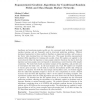518 search results - page 16 / 104 » Learning associative Markov networks |
ECAI
2008
Springer
13 years 9 months ago
2008
Springer
Time is a crucial variable in planning and often requires special attention since it introduces a specific structure along with additional complexity, especially in the case of dec...
JMLR
2008
13 years 7 months ago
2008
Log-linear and maximum-margin models are two commonly-used methods in supervised machine learning, and are frequently used in structured prediction problems. Efficient learning of...
GLOBECOM
2010
IEEE
13 years 5 months ago
2010
IEEE
Abstract--Sensors equipped with energy harvesting and cooperative communication capabilities are a viable solution to the power limitations of Wireless Sensor Networks (WSNs) assoc...
ACII
2011
Springer
12 years 7 months ago
2011
Springer
Affect plays a vital role in learning. During tutoring, particular affective states may benefit or detract from student learning. A key cognitiveaffective state is confusion, which...
JUCS
2010
13 years 6 months ago
2010
: One of the success factors of Work Integrated Learning (WIL) is to provide the appropriate content to the users, both suitable for the topics they are currently working on, and t...

